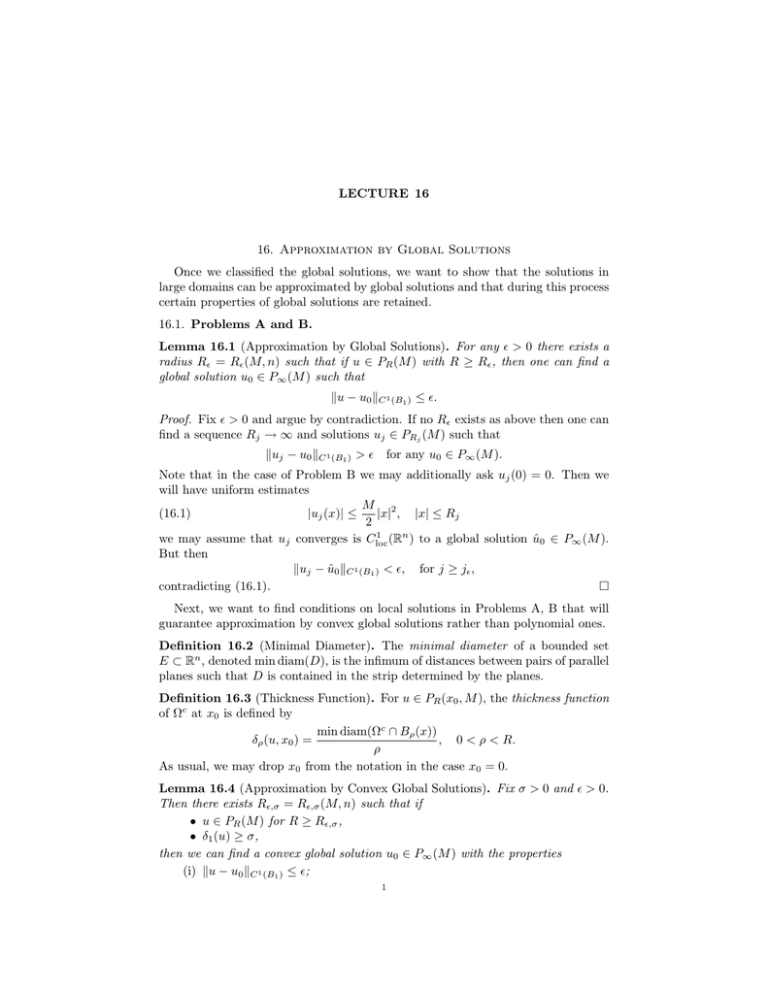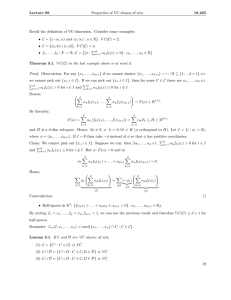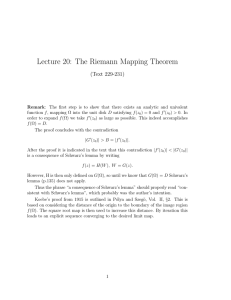LECTURE 16 16. Approximation by Global Solutions Once we
advertisement

LECTURE 16
16. Approximation by Global Solutions
Once we classified the global solutions, we want to show that the solutions in
large domains can be approximated by global solutions and that during this process
certain properties of global solutions are retained.
16.1. Problems A and B.
Lemma 16.1 (Approximation by Global Solutions). For any > 0 there exists a
radius R = R (M, n) such that if u ∈ PR (M ) with R ≥ R , then one can find a
global solution u0 ∈ P∞ (M ) such that
ku − u0 kC 1 (B1 ) ≤ .
Proof. Fix > 0 and argue by contradiction. If no R exists as above then one can
find a sequence Rj → ∞ and solutions uj ∈ PRj (M ) such that
kuj − u0 kC 1 (B1 ) > for any u0 ∈ P∞ (M ).
Note that in the case of Problem B we may additionally ask uj (0) = 0. Then we
will have uniform estimates
M 2
|x| , |x| ≤ Rj
(16.1)
|uj (x)| ≤
2
1
we may assume that uj converges is Cloc
(Rn ) to a global solution û0 ∈ P∞ (M ).
But then
kuj − û0 kC 1 (B1 ) < , for j ≥ j ,
contradicting (16.1).
Next, we want to find conditions on local solutions in Problems A, B that will
guarantee approximation by convex global solutions rather than polynomial ones.
Definition 16.2 (Minimal Diameter). The minimal diameter of a bounded set
E ⊂ Rn , denoted min diam(D), is the infimum of distances between pairs of parallel
planes such that D is contained in the strip determined by the planes.
Definition 16.3 (Thickness Function). For u ∈ PR (x0 , M ), the thickness function
of Ωc at x0 is defined by
min diam(Ωc ∩ Bρ (x))
, 0 < ρ < R.
δρ (u, x0 ) =
ρ
As usual, we may drop x0 from the notation in the case x0 = 0.
Lemma 16.4 (Approximation by Convex Global Solutions). Fix σ > 0 and > 0.
Then there exists R,σ = R,σ (M, n) such that if
• u ∈ PR (M ) for R ≥ R,σ ,
• δ1 (u) ≥ σ,
then we can find a convex global solution u0 ∈ P∞ (M ) with the properties
(i) ku − u0 kC 1 (B1 ) ≤ ;
1
2
LECTURE 16
(ii) there exists a ball B = Bρ (x) ⊂ B1 of radius ρ = σ/2n such that B ⊂
Ωc (u0 ).
(iii) Bρ/2 (x) ⊂ Ωc (u).
Proof. As before, we argue by contradiction. If no R,σ exists as above, then we
can find a sequence Rj → ∞ and solutions uj ∈ Prj (M ) such that
δ1 (uj ) ≥ σ
and that for any global solution u0 ∈ P∞ (M ) at least one of the conditions (i)–(iii)
in the lemma fails.
Now, we again have uniform estimates
|uj (x)| ≤
M 2
|x| ,
2
|x| ≤ Rj
1
and therefore without loss of generality we may assume that uj converges in Cloc
(Rn )
to a global solution û0 ∈ P∞ (M ). Thus,
kuj − û0 kC 1 (B1 ) < for j ≥ j ,
i.e. the condition (i) in the lemma is satisfied.
To show that in fact (ii) and (iii) are also satisfied with this choice of global
solution, we note that
δ1 (û0 ) ≥ σ,
otherwise, we would have δ1 (uj ) < σ for large j. This implies that û0 cannot be a
polynomial solution. Thus, by the classification of global solutions û0 is a convex
function and Ωc (û0 ) is a convex set.
To proceed, we will need the following lemma of F. John on convex sets.
Lemma 16.5 (F. John). If C is a convex body and E is the ellipsoid of largest
volume contained in C, then C ⊂ nE (after we choose the origin at the center of
E).
Applying this lemma to the convex set C = Ωc (û0 ) ∩ B1 , we obtain that C
contains a ball B of radius ρ = σ/2n. Indeed, if E has one of its diameters smaller
than 2ρ then nE has one of its diameters smaller than 2nρ = 1 and C is contained
in a strip of width smaller than 1, a contradiction.
Thus, (ii) is satisfied. Finally, (iii) follows from nondegeneracy for large j.
We arrived at a contradiction since all conditions are satisfied by û0 . Hence the
lemma follows.
16.2. Problem C. In the case of the two-phase obstacle problem, we specify a
condition that guarantees the approximation by two-plane solutions.
Lemma 16.6 (Approximation by Two-Plane Solutions). For any > 0 there exist
R = R (M, n) and σ = σ (M, n) such that if
• u ∈ PR (M ) with R ≥ R
• |∇u(0)| ≤ σ ,
• dist(0, ∂{u > 0}) ≤ σ , dist(0, ∂{u < 0}) ≤ σ
then there exits a two-plane global solution u0 ∈ P∞ (M ) such that
ku − u0 kC 1 (B1 ) ≤ .
LECTURE 16
3
Proof. As before, fix > 0 and assume the statement is false. Then we can find
sequences Rj → ∞, σj → 0, and solutions uj ∈ PRj (M ) such that
|∇uj | ≤ σj ,
dist(0, ∂{uj > 0}) ≤ σj , dist(0, ∂{uj < 0}) ≤ σj
but so that
kuj − û0 kC 1 (B1 ) > for any u0 ∈ P∞ (M ).
Noticing that we have uniform estimates
|∇uj (x)| ≤ (1 + M )|x|,
|x| < Rj
1
for j large enough, we may assume that uj → û0 ∈ P∞ (M ) in Cloc
(Rn ).
0
We claim that 0 is a branching point for û . Indeed,
|∇û0 (0)| = lim |∇uj (0)| = 0.
j→∞
Also, it is not hard to see that 0 ∈ ∂{u0 > 0} ∩ ∂{u0 < 0} by using the nondegeneracy property. Hence 0 is a branching point. But then Theorem 15.7 implies that
û0 is a two-plane solution and we arrive at a contradiction, as
kuj − û0 kC 1 (B1 ) < for j ≥ j .






